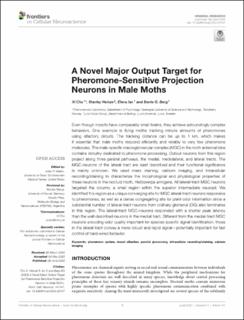| dc.contributor.author | Chu, Xi | |
| dc.contributor.author | Heinze, Stanley | |
| dc.contributor.author | Ian, Elena | |
| dc.contributor.author | Berg, Bente Gunnveig | |
| dc.date.accessioned | 2020-06-09T07:17:50Z | |
| dc.date.available | 2020-06-09T07:17:50Z | |
| dc.date.created | 2020-06-08T15:59:33Z | |
| dc.date.issued | 2020 | |
| dc.identifier.citation | Frontiers in Cellular Neuroscience. 2020, 14 (147) | en_US |
| dc.identifier.issn | 1662-5102 | |
| dc.identifier.uri | https://hdl.handle.net/11250/2657270 | |
| dc.description.abstract | Even though insects have comparably small brains, they achieve astoundingly complex behaviors. One example is flying moths tracking minute amounts of pheromones using olfactory circuits. The tracking distance can be up to 1 km, which makes it essential that male moths respond efficiently and reliably to very few pheromone molecules. The male-specific macroglomerular complex (MGC) in the moth antennal lobe contains circuitry dedicated to pheromone processing. Output neurons from this region project along three parallel pathways, the medial, mediolateral, and lateral tracts. The MGC-neurons of the lateral tract are least described and their functional significance is mainly unknown. We used mass staining, calcium imaging, and intracellular recording/staining to characterize the morphological and physiological properties of these neurons in the noctuid moth, Helicoverpa armigera. All lateral-tract MGC neurons targeted the column, a small region within the superior intermediate neuropil. We identified this region as a unique converging site for MGC lateral-tract neurons responsive to pheromones, as well as a dense congregating site for plant odor information since a substantial number of lateral-tract neurons from ordinary glomeruli (OG) also terminates in this region. The lateral-tract MGC-neurons responded with a shorter peak latency than the well-described neurons in the medial tract. Different from the medial-tract MGC neurons encoding odor quality important for species-specific signal identification, those in the lateral tract convey a more robust and rapid signal—potentially important for fast control of hard-wired behavior. | en_US |
| dc.language.iso | eng | en_US |
| dc.publisher | Frontiers Media | en_US |
| dc.rights | Navngivelse 4.0 Internasjonal | * |
| dc.rights.uri | http://creativecommons.org/licenses/by/4.0/deed.no | * |
| dc.title | A novel major output target for pheromone-sensitive projection neurons in male moths | en_US |
| dc.type | Peer reviewed | en_US |
| dc.type | Journal article | en_US |
| dc.description.version | publishedVersion | en_US |
| dc.source.volume | 14 | en_US |
| dc.source.journal | Frontiers in Cellular Neuroscience | en_US |
| dc.source.issue | 147 | en_US |
| dc.identifier.doi | 10.3389/fncel.2020.00147 | |
| dc.identifier.cristin | 1814424 | |
| dc.description.localcode | Copyright © 2020 Chu, Heinze, Ian and Berg. This is an open-access article distributed under the terms of the Creative Commons Attribution License (CC BY). The use, distribution or reproduction in other forums is permitted, provided the original author(s) and the copyright owner(s) are credited and that the original publication in this journal is cited, in accordance with accepted academic practice. No use, distribution or reproduction is permitted which does not comply with these terms. | en_US |
| cristin.ispublished | true | |
| cristin.fulltext | original | |
| cristin.qualitycode | 1 | |

